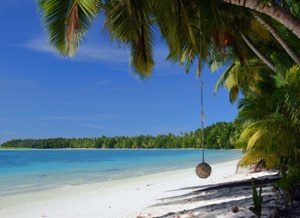Chagos: Cruiser Paradise Found
A stop in Chagos represents some of the most privileged access in the world. It’s a UK overseas territory, managed by the BIOT—British Indian Ocean Territory authority. Many circumnavigators call Chagos out among their favorite stops and this report says why it is so special.
Published 10 years ago, updated 4 years ago


Chagos is stunning
The two small, uninhabited atolls where cruising boats may stop are a veritable tropical utopia. They epitomize the ideal: pristine white beaches circle verdant islands where tall palms reach out over the sand, dropping the occasional coconut. Turquoise shallows meet sapphire water in the depths of the lagoon, and coral heads scattered throughout explode in colourful shapes and intricate forms. Just five degrees south of the equator, the climate is hot but tempered by the ocean breeze.
Chagos is remote
It’s not easy to get here. The islands are situated near the centre of the Indian Ocean: Indonesia is 1700 nautical miles to the east and Tanzania is 2000 to the west, so even the newly fledged yachties from Australia have packed a significant passage (or two) before making landfall, and the common passages from Chagos – to Seychelles or Mauritius – average around 1200 nautical miles.
Nature rules
Dropping anchor is an invitation for sharks to visit the newcomer; resident fish from the nearest coral head come up to investigate. The only sounds from a placid anchorage are fairy terns singing in the trees and the distant roar of surf crashing seaward side of the reef. No aeroplanes break the blue skies overhead; just frigate birds circling to find their next meal. Step ashore and it seems for a moment as if the sand is moving until you realize it’s just the multitudes of hermit crabs crawling along the beach. There’s no road or wharf or habitable dwelling, just moss-covered ruins that hint at a former settlement: the occasional stone foundation or coral-block structures, roofs long gone, walls wrapped in the unyielding embrace of mature tree roots. Press through the dense growth of a coconut plantation gone wild (a machete and shoes more robust than flip flops are handy), and the call or terns is only interrupted by the scratch of coconut crabs rustling in the dry leaves of fallen palm fronds.
Visiting Chagos is a privilege
A stop in Chagos represents some of the most privileged access in the world. It’s a UK overseas territory, managed by the BIOT—British Indian Ocean Territory authority. There is no civilian transportation available to reach the islands. BIOT requires an application process with proof of insurance (for medical evacuation and wreck removal) to be met before granting permits of up to four weeks. No doubt the Chagossians wish they had easier access to their homeland.
Self-sufficiency required
In the atolls cruisers visit, they are the only human inhabitants; Chagos is chance to subsist on a combination of what you bring and what you hunt. With a lagoon full of fish and islands full of coconut palms, it doesn’t take much! A few wells of fresh water remain, and it’s not hard to forage: our fishing skills are only average, but we’ve had fresh fish for dinner most nights.
It wasn’t long ago that cruisers could stay here for months and months, and many did-sailing in with the wind from one season, remaining for six months or more and returning when the winds switched for a downhill ride in both directions. Some stayed long enough to get scurvy; others planted vegetables and fruit trees to supplement their diet. Many returned year after year, leaving buried caches of fuel or stores for their return.
Minimal bureaucracy
There are a few rules, but there’s minimal oversight, which satisfies the broad streak of independence that exists in many cruisers. The only administrative presence is an irregular visit from officialdom to check present boats against permits and ensure the BIOT regulations are respected. It’s not hard: catch no more than you can eat. No spearguns-hook and line only. Don’t take coconut crabs. Don’t harvest palms. Don’t build structures on shore. The days when Chagos was a kind of Fiddler’s Green may be over, but there’s still plenty of room for a seasonal cruising dominion of sorts.
Behan
SV Totem
Related to following destinations: BIOT (Chagos)
Related to the following Cruising Resources: Indian Ocean, Off the Beaten Path, Routing




